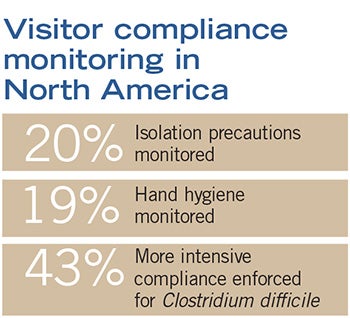Report offers guidelines for visitor contact precautions in cases of infectious disease
 |
| SOURCE: INFECTION CONTROL & HOSPITAL EPIDEMIOLOGY, APRIL 2015 |
Because pathogens present varying levels of risk to those who come into contact with them, health care facilities need to tailor their contact precaution policies for visitors of patients with infection diseases.
A report published in Infection Control & Hospital Epidemiology says that hospitals can eliminate the use of contact precautions for visitors in some cases.
“Visitors to patients with methicillin-resistant Staphylococcus aureus (MRSA) or vancomycin-resistant enterococci (VRE) do not need to wear gowns and gloves,” says Silvia Munoz-Price, M.D., lead author of the report and enterprise epidemiologist for Froedtert Health System in Milwaukee. She also is associate professor of medicine, Institute for Health and Society and the division of infectious diseases, both at the Medical College of Wisconsin in Milwaukee.
“This recommendation applies to hospital settings where MRSA and VRE are widespread, which is the case in most of the United States,” she says.
Munoz-Price says that visitors generally do not go to more than one room to visit patients, so they do not serve as potential vectors across the hospital, unlike clinical staff.
“This guidance can help hospitals save money,” she says about eliminating unneeded contact precautions.
There are exceptions to that recommendation. If visitors were to see more than one patient in a facility, they should use gloves and gowns as a precaution when visiting MRSA and VRE patients, she adds.
Because pathogens such as Clostridium difficile and Norovirus are potentially harmful to visitors, the report recommends using contact precautions in those cases, too.
Munoz-Price says another potential cost-saving measure for hospitals is to eliminate the policy of giving N95 respirators to visitors of patients placed in airborne isolation with an infection such as tuberculosis. The device provides no help unless the user has been fitted to wear one, Munoz-Price says.
“Consideration should be given to restricting visitation among visitors without previous documented exposure to the symptomatic patient,” she says.
The guidelines also recommend that visitors of patients with infectious diseases need to maintain effective hand hygiene to reduce the potential for spreading dangerous bacteria within the health care facility and the community.
Promoting hand hygiene can lead to increased rates of compliance among hospital visitors, the report states.
The authors advise that hospitals should implement the report’s guidelines only if they can enforce and evaluate the policy they implement. But most facilities do not monitor visitor compliance, according to a survey of nearly 300 Society for Healthcare Epidemiology of America (SHEA) members, which was part of the report.
The survey found that 80 percent of the North American respondents do not monitor visitor compliance with isolation precautions and 81 percent do not monitor hand-hygiene compliance.
Enforcement of compliance for visitors of patients with more serious infections was higher. Of the respondents, 44 percent enforce compliance for visitors of patients with carbapenem-resistant Enterobacteriaceae and 43 percent enforce compliance for visitors of patients with C. difficile.


